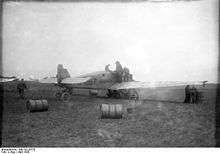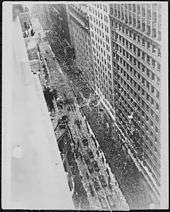Bremen (aircraft)
| Bremen | |
|---|---|
 | |
| "Bremen" after the transatlantic crossing | |
| Type | Junkers W 33 |
| Construction number | 2504 |
| Registration | D-1167 |
| Fate | Preserved |
| Preserved at | Bremen Airport Museum |
The Bremen is a German Junkers W 33 aircraft that made the first successful transatlantic aeroplane flight from east to west between April 12 and 13, 1928.
The Bremen left Baldonnel Aerodrome, Ireland on April 12 and flew to Greenly Island, Canada, arriving on April 13, after a flight fraught with difficult conditions and compass problems. The crew consisted of pilot Captain Hermann Köhl, the navigator, Major James Fitzmaurice, and the owner of the aircraft, Ehrenfried Günther Freiherr von Hünefeld.
Flight log

- 12 Apr, 05:09 GMT: Started engine of the Bremen at Baldonnel Aerodrome (about 19 km (12 mi) southwest of Dublin).
- 12 Apr, 05:38 GMT: Lifted off from Baldonnel Airport and headed west.
- 12 Apr, 07:05 GMT: The Bremen passed the Slyne Head Lighthouse in County Galway, started across the Atlantic, and headed for Mitchel Field, Long Island, New York while maintaining an altitude of 1,500 feet (460 m) and an airspeed of 200 kilometres per hour (120 mph)
- 12 Apr, 09:00 GMT: The crew started their first meal aloft: hot bouillon and sandwiches.
- 12 Apr, 13:45 GMT: Bremen crossed the 30th meridian west. Surface speed was over 90 knots (170 km/h; 100 mph).
- 12 Apr, 16:00 GMT: Bremen climbed to 610 m (2,000 ft).
- 12 Apr, 21:00 GMT: Crew made their last drift calculation.
When the sun disappeared and the clouds obscured the stars, the Bremen climbed to 6,000 feet (1,800 m). Köhl estimated that they were then about three hours from land. If they had been able to stay on course, his estimate would have proven to have been correct. In fact, without the aid of the north star, they then relied on a magnetic compass and drifted far off course toward the north.
- 13 Apr, 06:50 GMT: They saw Polaris again. James then estimated that their magnetic compass was in error by 40 degrees. Köhl immediately turned southwesterly to follow the east coast of North America towards Mitchel Field on New York's Long Island, which was then about 1,500 miles (2,400 km) south of the Bremen. They flew among the Torngat Mountains of Labrador and then (without recognizing any landmarks) followed the George River upstream. In order to minimize the adverse effect of a strong southwest wind, Köhl descended into the George River Valley and flew at an altitude of 10 feet (3.0 m).
- 13 Apr, 14:00 GMT: The Bremen passed over the lakes at the source of the George. The crew saw nobody on the ground but people on the ground sighted the plane.
- 13 Apr, 15:00 GMT: The Bremen was seen flying over North West River on the shore of Lake Melville.
- 13 April: At about 17:50 GMT, with about two hours of fuel remaining, and only a general knowledge of their location, the crew spotted a lighthouse on an island with a pack of dogs and four people. The island was Greenly Island in the Strait of Belle Isle, which separates Newfoundland from Labrador and Quebec on the mainland. Greenly Island is about 4 miles (6.4 km) inside the boundary of the province of Quebec.
Landing

When the Bremen landed on Greenly Island, the first Canadian aircraft to reach the scene was piloted by Duke Schiller and the second machine was flown by the Canadian Transcontinental Airways Company's Chief Pilot - Romeo Vachon who arrived two days later with a group of media representatives. Both Schiller and Vachon were flying Fairchild FC-2W machines; G-CAIQ (Schiller) and G-CAIP (Vachon). Gretta May Ferris, a nurse from Saint John, New Brunswick who was posted at nearby Forteau's Grenfell Medical Station, travelled by dogsled some 15 miles (24 km) to attend to the crew's medical needs; she was the first to write the story that was picked up by the international media saying that the Bremen had landed and that the crew were safe.
The clock in the lighthouse was remembered (by the family of the lighthouse keeper) as indicating 2 p.m. Atlantic Time when the Bremen was first sighted from the ground. Captain Köhl and Baron von Hünefeld said that they were in the air 36½ hours. If their statements of elapsed time had an accuracy of better than one minute, which is unlikely, then the time of touchdown was 18:08 GMT or 13:08 EST or 14:08 Atlantic Time.
Alfred Cormier of Long Point (Lourdes-de-Blanc-Sablon), who operated the local telegraph office from his home, made contact with Marconi station VCL at Point Amour in Labrador—18 miles (29 km) east of Long Point. From there, his message went through St. John's, Newfoundland (at 6:30 p.m.) and Louisbourg, Nova Scotia. It was forwarded by land lines across Canada and via Radio Corporation of America (RCA) station WCC at Chatham, Massachusetts, for transmission to New York City.
The first message read: "German plane at Greenly Island, wind southeast, thick."
A short time later, a second message was sent: "German plane Bremen landed Greenly Island, noon, slightly damaged, crew well."
By 7:15 p.m., the story was in all the newsrooms of the eastern seaboard.

Status
The Bremen belongs to the Henry Ford Museum in Dearborn, Michigan, but is currently on display in a hangar at the Bremen Airport Museum where it has been completely restored.[1]
See also
References
- ↑ Wir holen die Bremen nach Bremen
Further reading
- The most recent book on this subject is titled The Bremen by Fred W. Hotson; published by CANAV Books, 51 Balsam Ave., Toronto ON M4E 3B6; 1988.
- Source for Crew and Date changes: Chronicle of Aviation, 1992, Published by JL International Publishing, Missouri.
- Thomas Keane, The Weather and the First Successful Non-Stop East to West Trans-Atlantic Flight of 1928 at http://edepositireland.ie/handle/2262/73544
External links
| Wikimedia Commons has media related to Bremen (aircraft). |